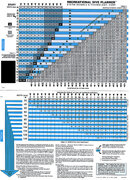Tom Agneessens
Registered
Hello,
Can you help me in finding the origin of the simplified rule that says that one can dive NDL (no-deco) for 20min @ 30msw on air / 45à50min @ 20msw ?
This seems to be a generally accepted rule of thumb in ratio calculations (Gue,UTD,ISE,...)
Except for the IANTD OW & NAUI tables, that come close to it, I cannot find the rationale behind it?
Thank you in advance
Tom
Can you help me in finding the origin of the simplified rule that says that one can dive NDL (no-deco) for 20min @ 30msw on air / 45à50min @ 20msw ?
This seems to be a generally accepted rule of thumb in ratio calculations (Gue,UTD,ISE,...)
Except for the IANTD OW & NAUI tables, that come close to it, I cannot find the rationale behind it?
Thank you in advance
Tom








